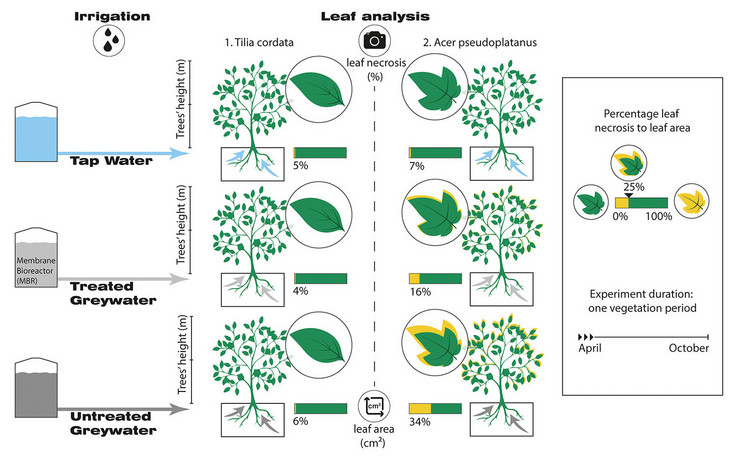New publication: Suitability of greywater for irrigation (Gräf et al. 2022)
Application of leaf analysis in addition to growth assessment to evaluate the suitability of greywater for irrigation of Tilia cordata and Acer pseudoplatanus
Water is the key resource in fulfilling the cooling function of plants in urban environments and needs to be supplied reliably and adequately, especially during dry periods. To avoid an unsustainable use of high-quality drinking water for irrigation, the reuse of greywater should be implemented for Green Infrastructure irrigation in the sense of the circular economy. In this study, the influence of greywater irrigation on vitality of two trees species, Tilia cordata and Acer pseudoplatanus, was determined by investigating the effect of irrigation with raw or treated greywater in comparison to municipal tap water. Plant growth parameters were measured, including leaf area, number of leaves, average leaf area and annual growth. In addition, the relative chlorophyll content was determined and image analysis was used to identify vital and necrotic leaf parts. While treatment did not affect growth after one growing season A. pseudoplatanus had significantly higher leaf necrosis (34.8%) when irrigated with raw greywater compared to treated greywater (15.5%) and tap water (5.8%). Relative chlorophyll content of T. cordata irrigated with tap water decreased over time until it was significantly lower (28.5) then the greywater treatments (34.5 and 35). Image analysis of leaves to quantify necrosis proved to be a sensitive method to quantify plant health and showed negative effects earlier than an analysis of growth. Anionic surfactants and electrical conductivity had a significant influence on plant vitality. Therefore, plant selection should take these parameters into account, when planning green infrastructure irrigated with greywater.
https://www.sciencedirect.com/science/article/pii/S004896972202842X

